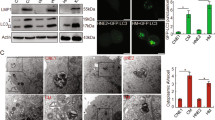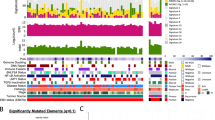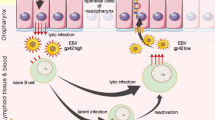ABSTRACT
Latent membrane protein 1 (LMP1), an important protein encoded by Epstein Barr virus (EBV), has been implied to link with the pathogenesis of nasopharyngeal carcinoma (NPC). Its dual effects of increasing cell proliferation and inhibiting cell apoptosis have been confirmed. In this study, we showed that the expression of Survivin and CDK4 protein in CNE-LMP1, a LMP1 positive NPC epithelial cell line, is higher than in LMP1 negative NPC epithelial cell line-CNE1, and the expression is LMP1 dosage-dependent. Although it was reported that Survivin specifically expressed in cell cycle G2/M phase, our studies suggested that LMP1 could promote the expression of Survivin in G0/G1, S and G2/M phase. It also showed that Survivin and CDK4 could be accumulated more in the nuclei triggered by LMP1. More interestingly, Survivin and CDK4 could form a protein complex in the nuclei of CNE-LMP1 rather than in that of CNE1, which demonstrated that the interaction between these two proteins could be promoted by LMP1. These results strongly suggested that the role of LMP1 in the regulation of Survivin and CDK4 may also shed some light on the mechanism research of LMP1 in NPC.
Similar content being viewed by others
Log in or create a free account to read this content
Gain free access to this article, as well as selected content from this journal and more on nature.com
or
References
Eudoxia H, George M . Cellular signaling pathway engaged by the Epstein-barr virus transforming protein LMP1. Front Biosci 2002; 7:319–29.
Huen DS, Henderson SA, Croom-Carter D, et al. The Epstein-Barr virus latent membrane protein-1(LMP1) mediates activation of NF-êB and cell surface phenotype via two effector regions in its carboxy-terminal cytoplasmic domain. Oncogene 1995; 10:549–60.
Mitchell T, Sugden B . Stimulation of NF-kappa B- mediated transcription by mutant derivatives of the latent membrane protein of Epstein-Barr virus. J virol 1995; 69:2968–76.
Kieser A, Kilger EO, Gires O, et al. Epstein-Barr virus latent membrane protein-1 triggers AP-1 activity via the c-Jun N –terminal kinase cascade. EMBO J 1997; 16:6478–85.
Luo FJ, Hu Z, Deng XY, et al. Epstein-Barr virus LMP-1 activated AP-1 mediated by JNK in Nasopharyngeal cell line. Zhongguo Sheng Wu Hua Xue Yu Fen Zi Sheng Wu Xue Bao 2001; 17:381–5.
Gires O, Kohlhuber F, Kilger E, et al. Latent membrane protein 1 of Epstein-Barr virus interacts with JAK3 and activates STAT protein. EMBO J 1999; 18:3064–73.
Tan YN, Tao YG, Song X, et al. Expression of JAK3 in Nasopharyngeal Carcinoma Cell Line Associated With STAT Activation Regulate by EB Virus Encoded Protein LMP1. Sheng Wu Hua Xue Yu Sheng Wu Wu Li Jin Zhan 2003; 30:560–5.
Li F, Ambrosini G, Chu EY, et al. Control of apoptosis and mitotic spindle checkpoint by Survivin. Nature 1998; 396:580–4.
Li F, Altieri DC . The cancer antiapoptosis mouse Survivin gene: characterization of locus and transcriptional requirements of basal and cell cycle-dependent expression. Cancer Res 1999; 59:3143–51.
Zhao J, Tenev T, Martins LM, et al. The ubiquitin-proreasome pathway regulates survivin degradation in a cell cycle-dependent manner. J Cell Sci 2000; 113:4363–7.
Tang FQ, Cao Y . Epstein-Barr virus LMP1 triggers the expression of inhibitor of apoptosis protein Survivin via NFêB and AP-1 signaling pathway in nasopharyngeal carcinoma. Exp Oncol 2003; 25:28–32.
Tang FQ, Gu HH, Hu Z, et al. EB virus latent membrane protein 1 initiates cells proliferation and inhibits apoptosis via Survivin triggering signal-Pathway. Zhongguo Sheng Wu Hua Xue Yu Fen Zi Sheng Wu Xue Bao 2003; 19:646–52.
Zhao XR, Wang CX, Luo FJ, et al. The Epstein-Barr Virus Encoded Latent Membrane Protein 1(EBV-LMP1)Activates Expression of CyclinD1. Sheng Wu Hua Xue Yu Sheng Wu Wu Li Jin Zhan 2001; 28:704–10.
Song X, Ai MD, Chen XX, et al. Regulation of c-Jun/JunB heterodimers mediated by Epstein-Barr virus encoded latent membrane protein 1 on p16. Chin Sci Bull 2004; 49: 676–83.
Suzuki A, Ito T, Kawano H, et al. Survivin initiates procaspase3/P21 complex formation as a result of interaction with CDK4 to resist Fas-mediated cell death. Oncogene 2000; 19:1346–53.
Suzuki A, Hayashida M, Ito T, et al. Survivin initiates cell cycle entry by the competitive interaction with Cdk4/p16(INK4a) and Cdk2/cyclin E complex activation. Oncogene 2000; 19:3225–34.
Liao W, Yi H, Li XY, et al. Doxycycline dependent expression of EBV latent membrane protein 1 with Tet regulating system in Nasopharygeal Carcinomacell line. Sheng Wu Hua Xue Yu Sheng Wu Wu Li Xue Bao 1999; 31:309–12.
Skomedal H, Kristensen GB, Lie AK, et al. Aberrant expression of the cell cycle associated proteins TP53, MDM2, p21, p27, CDK4, cyclin D1, RB, and EGFR in cervical carcinomas. Gynecol Oncol 1999; 73:223–8.
Chen Q, Luo G, Li B, et al. Expression of p16 and CDK4 in oral premalignant lesions and oral squamous cell carcinomas: a semi-quantitative immunohistochemical study. J Oral Pathol Med 1999; 28:158–64.
Wunder JS, Eppert K, Burrow SR, et al. Co-amplification and overexpression of CDK4, SAS and MDM2 occurs frequently in human parosteal osteosarcomas. Oncogene 1999; 18:783–8.
Benassi MS, Molendini L, Gamberi G, et al. Altered G1 phase regulation in osteosarcoma. Int J Cancer 1997; 74:518–22.
Maelandsmo GM, Berner JM, Florenes VA, et al. Homozygous deletion frequency and expression levels of the CDKN2 gene in human sarcomas—relationship to amplification and mRNA levels of CDK4 and CCND1. Br J Cancer 1995; 72:393–8.
An HX, Beckmann MW, Reifenberger G, et al. Gene amplification and overexpression of CDK4 in sporadic breast carcinomas is associated with high tumor cell proliferation. Am J Pathol 1999; 154:113–8.
Yao J, Pollock RE, Lang A, et al. Infrequent mutation of the p16/MTS1 gene and overexpression of cyclin-dependent kinase 4 in human primary soft-tissue sarcoma. Clin Cancer Res 1998; 4:1065–70.
Rollbrocker B, Waha A, Louis DN, et al. Amplification of the cyclin-dependent kinase 4 (CDK4) gene is associated with high cdk4 protein levels in glioblastoma multiforme. Acta Neuropathol (Berl) 1996; 92:70–4.
Kitahara K, Yasui W, Yokozaki H, et al. Expression of cyclin D1, CDK4 and p27KIP1 is associated with the p16MTS1 gene status in human esophageal carcinoma cell lines. J Exp Ther Oncol 1996; 1:7–12.
Zhang T, Nanney LB, Luongo C, et al. Concurrent overexpression of cyclin D1 and cyclin-dependent kinase 4 (Cdk4) in intestinal adenomas from multiple intestinal neoplasia (Min) mice and human familial adenomatous polyposis patients. Cancer Res 1997; 57:169–75.
Maelandsmo GM, Florenes VA, Hovig E, et al. Involvement of the pRb/p16/cdk4/cyclin D1 pathway in the tumorigenesis of sporadic malignant melanomas. Br J Cancer 1996; 73:909–16.
Qiu C, Shan L, Yu M, et al. Deregulation of the cyclin D1/Cdk4 retinoblastoma pathway in rat mammary gland carcinomas induced by the food-derived carcinogen 2-amino-1-methyl-6-phenylimidazo [4,5-b] pyridine. Cancer Res 2003; 63:5674–8.
Izawa H, Yamamoto H, Ikeda M, et al. Analysis of cyclin D1 and CDK expression in colonic polyps containing neoplastic foci: a study of proteins extracted from paraffin sections. Oncol Rep 2002; 9:1313–8.
Kim H, Ham EK, Kim YI, et al. Overexpression of cyclin D1 and cdk4 in tumorigenesis of sporadic hepatoblastomas. Cancer Lett 1998; 131:177–83.
Martinez A, Bellosillo B, Bosch F, et al. Nuclear survivin expression in mantle cell lymphoma is associated with cell proliferation and survival. Am J Pathol 2004; 164:501–10.
Grabowski P, Kuhnel T, Muhr-Wilkenshoff F, et al. Prognostic value of nuclear survivin expression in oesophageal squamous cell carcinoma. Br J Cancer 2003; 88:115–9.
Moon WS, Tarnawski AS . Nuclear translocation of survivin in hepatocellular carcinoma: a key to cancer cell growth? Hum Pathol 2003; 34:1119–26.
Akiyama M, Hideshima T, Hayashi T, et al. Nuclear factor-êB P65 mediates tumor necrosis factor á-induced nuclear translocation of telomerase reverse transcriptase protein. Cancer Res 2003; 63:18–21.
Rickinson AB . Epstein–Barr Virus in Action in Vivo. N Engl J Med. 1998; 338:1461–3.
Chandele A, Prasad V, Jagtap JC, et al. Upregulation of survivin in G2/M cells and inhibition of caspase 9 activity enhances resistance in staurosporine-induced apoptosis. Neoplasia 2004; 6:29–40.
Johnson AL, Langer JS, Bridgham JT . Survivin as a cell cycle-related and antiapoptotic protein in granulosa cells. Endocrinology 2002; 143:3405–13.
Rodriguez JA, Span SW, Ferreira CG, et al. CRM1-mediated nuclear export determines the cytoplasmic localization of the antiapoptotic protein Survivin. Exp Cell Res. 2002; 275:44–53.
Acknowledgements
The authors would like to thank Dr Qiao WU (Key Laboratory of the Ministry of Education for Cell Biology and Tumor Cell Engineering, Xiamen University, China) and Dr Zhi Min YUAN (Department of Cancer Cell Biology, Harvard School of Public Health, USA) for their helpful discussions.
This work was supported by National Nature Science Foundation for Distinguished Young Scholar of China (No. 39525022), National Basic Research Program (No. 2004CB518703), and National Nature Science Foundation of China (No. 30570085).
Author information
Authors and Affiliations
Corresponding author
Rights and permissions
About this article
Cite this article
AI, M., LI, L., ZHAO, X. et al. Regulation of Survivin and CDK4 by Epstein-Barr virus encoded latent membrane protein 1 in nasopharyngeal carcinoma cell lines. Cell Res 15, 777–784 (2005). https://doi.org/10.1038/sj.cr.7290347
Received:
Revised:
Accepted:
Issue date:
DOI: https://doi.org/10.1038/sj.cr.7290347
Keywords
This article is cited by
-
ARNTL hypermethylation promotes tumorigenesis and inhibits cisplatin sensitivity by activating CDK5 transcription in nasopharyngeal carcinoma
Journal of Experimental & Clinical Cancer Research (2019)
-
Cyclin-dependent kinase 1 and survivin as potential therapeutic targets against nasal natural killer/T-cell lymphoma
Laboratory Investigation (2019)
-
Preclinical evaluation of ribociclib and its synergistic effect in combination with alpelisib in non-keratinizing nasopharyngeal carcinoma
Scientific Reports (2018)
-
Epigenetic mediated zinc finger protein 671 downregulation promotes cell proliferation and tumorigenicity in nasopharyngeal carcinoma by inhibiting cell cycle arrest
Journal of Experimental & Clinical Cancer Research (2017)
-
Transducin β-like 1 X-linked receptor 1 suppresses cisplatin sensitivity in Nasopharyngeal Carcinoma via activation of NF-κB pathway
Molecular Cancer (2014)



